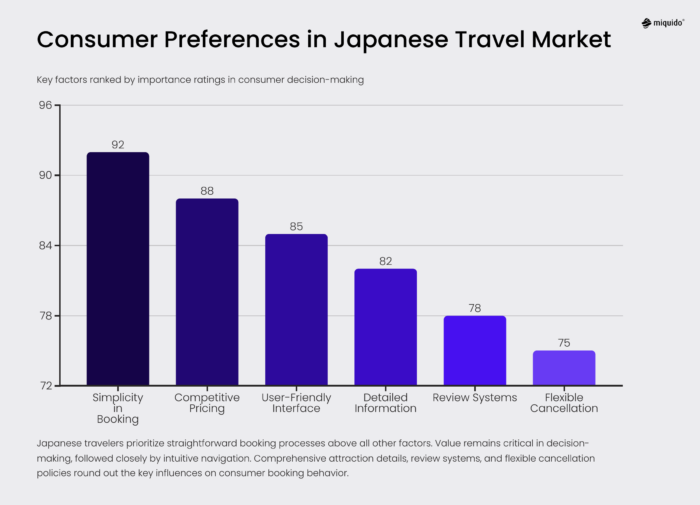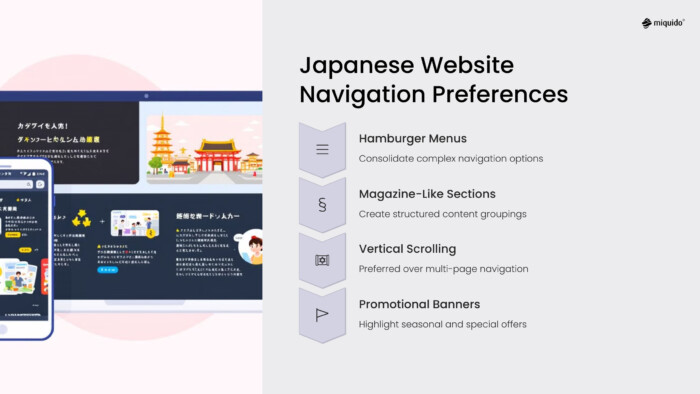Every new market is a new journey, and as with any journey, the more research you do, the smoother the path. As the experiences of global giants have shown, simply transplanting solutions from one market to another can lead to failure.
Thorough market research reveals what local users truly want, identifying their needs and habits. This insight allows for critical adjustments in digital products—just as our client in the travel industry discovered.
Project background: Challenges of expansion in the travel industry
A client operating in the travel industry planned to launch a booking platform in Asian markets. To gain a competitive edge, it was essential to precisely tailor the product to local users. This required a deep analysis of competitors, UX, and functionality to:
- Understand user habits, their interaction with booking platforms, and expected UX standards
- Identify the functionalities of dominant platforms that impact retention and conversion
- Adapt the strategy to the mobile nature of the market and high usability expectations
- Ensure UX localization, taking into account cultural, linguistic, and navigational differences
Approach: In-depth analysis of UX, competitors, and functionality
To provide the client with key information for making strategic decisions, a comprehensive analysis was conducted, covering:
- UX and user navigation – How do local users navigate the platforms? Do they prefer multi-level menus or scrolling?
- Benchmarking functionality – Which features dominate the market? What are the competitive advantages of market leaders?
- Mobile analysis – How are the best booking apps designed? What does mobile optimization look like?
- Role of AI and automation – How does artificial intelligence impact offer personalization and the booking process
- Conversion and retention model – Which loyalty mechanisms and pricing strategies effectively engage users?

Key findings: What did the analysis reveal?
UX: Scrolling vs clicking – Local user habits
The analysis revealed that users in Asian markets prefer scrolling over clicking, in contrast to European markets, where complex menus and page transitions dominate
- One-page layouts with long scrolling – Market leaders minimize clicks, presenting key information in a continuous structure
- Sticky CTAs and smooth animations – The “Book Now” button remains visible while scrolling, improving UX and conversion
- Dynamic content loading – Pages use lazy loading techniques to deliver content without interrupting scrolling

Mobile priority: Mobile-first UX
Over 90% of bookings in the target market were made via mobile devices. The competitor review showed that:
- Minimalist mobile interfaces – Simple, clean designs with large buttons and limited form fields
- Touch gestures and thumb navigation – Key UI elements (e.g., filters, booking, payment) are located at the bottom of the screen
- Fast mobile payments – Integration with e-wallets and QR codes has become the standard
Personalization and AI: Dynamic offer matching
Competitor platforms used AI for offer personalization, which had a direct impact on the time spent on the site and the number of completed bookings.
- Recommendations based on search history – Users receive personalized offers without needing to filter manually
- Dynamic pricing and predictive algorithms – Platforms use AI to optimize prices in real time
- Smart chatbots and voice search – Voice assistants and chatbots help with selecting attractions

Price transparency and new payment methods
In Asian markets, users expect full price transparency and flexible payment methods.
- Visible total costs (including taxes and fees) at the search stage
- “Book Now, Pay Later” option as a standard feature on competitive platforms
- Popularity of mobile and installment payments – Integration with local payment systems (WeChat Pay, PayPay, Alipay)

Summary
Through in-depth UX and functionality analysis, the client avoided costly mistakes, tailored the platform to local preferences, and optimized the product for mobility, scrolling, and AI. Key changes led to higher conversion rates and a successful expansion into the new market.

![[header] case study ux optimization and functionality analysis in the expansion of a booking platform into asian markets](https://www.miquido.com/wp-content/uploads/2025/04/header-case-study_-ux-optimization-and-functionality-analysis-in-the-expansion-of-a-booking-platform-into-asian-markets.jpg)


![[header] case study ux optimization and functionality analysis in the expansion of a booking platform into asian markets](https://www.miquido.com/wp-content/uploads/2025/04/header-case-study_-ux-optimization-and-functionality-analysis-in-the-expansion-of-a-booking-platform-into-asian-markets-432x288.jpg)
![[header] top 15 travel app features](https://www.miquido.com/wp-content/uploads/2017/09/header-top-15-travel-app-features-432x288.jpg)

![[header] how to build a travel search engin – a blueprint for ctos and product leaders](https://www.miquido.com/wp-content/uploads/2025/02/header-how-to-build-a-travel-search-engin-–-a-blueprint-for-ctos-and-product-leaders-432x288.jpg)